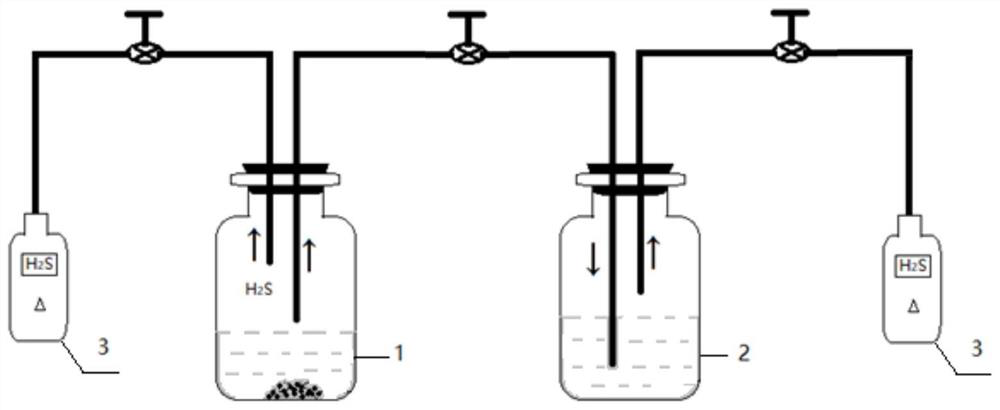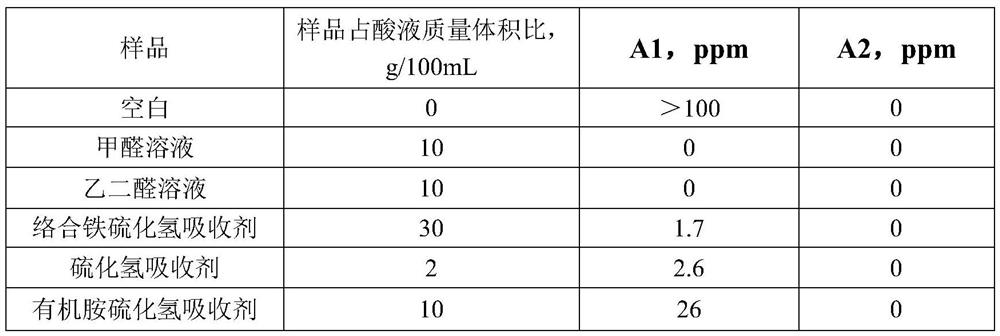A hydrogen sulfide absorbent for pickling and its application method
A technology of hydrogen sulfide and absorbent, applied in chemical instruments and methods, separation methods, separation of dispersed particles, etc., can solve problems such as limited deck space, inapplicability to widespread promotion and use, and increased operating costs, achieving a wide range of applications, Eliminate reservoir pollution damage, strong applicability
- Summary
- Abstract
- Description
- Claims
- Application Information
AI Technical Summary
Problems solved by technology
Method used
Image
Examples
Embodiment 1
[0050] 1) Connect the experimental device according to Figure 1;
[0051] 2) Open the caps of reaction bottle 1 and absorption bottle 2;
[0052] 3) Weigh 4.0g of pickling solution composed of ammonium chloride, urotropine, hydroxyalkyl triazine, ammonium persulfate and tetrasodium iminodisuccinate in a mass ratio of 37:37:18:1:7 The hydrogen sulfide absorbent is put into the reaction flask, and its mass volume ratio to the acid solution is 2.0g / 100mL; 1.0g of imidazoline acidification corrosion inhibitor is weighed and put into the reaction flask, and its mass volume ratio to the acid solution is 0.5g / 100mL; put 400mL of 200g / L sodium hydroxide solution into the absorption bottle to absorb the hydrogen sulfide gas overflowing from the reaction bottle;
[0053] 4) Measure 200mL of a compound organic acid solution containing 7.5% citric acid and 7.5% sulfamic acid by mass and inject it into reaction flask 1;
[0054] 5) Weigh 0.2 g of the downhole scale sample containing ferr...
Embodiment 2
[0062] 1) Connect the experimental device according to Figure 1;
[0063] 2) Open the caps of reaction bottle 1 and absorption bottle 2;
[0064] 3) Weigh 4.0 g of ammonium chloride, urotropine, hydroxyalkyl triazine, potassium persulfate and trisodium nitrilotriacetate in a mass ratio of 37:37:18:1:7 for pickling hydrogen sulfide Put the absorbent into the reaction bottle, and its mass volume ratio to the acid solution is 2.0g / 100mL; weigh 1.6g of aldehyde, ketone, and amine acidification corrosion inhibitors and put it into the reaction bottle, and its mass volume ratio to the acid solution is 0.8 g / 100mL; put 400mL of 200g / L sodium hydroxide solution in the absorption bottle to absorb hydrogen sulfide gas overflowing from the reaction bottle;
[0065] 4) Measure 200mL of a compound organic acid solution containing 10% citric acid and 5% sulfamic acid by mass and inject it into reaction flask 1;
[0066] 5) Weigh 0.2 g of the downhole sulfur-containing scale sample and put...
Embodiment 3
[0074] 1) Connect the experimental device according to Figure 1;
[0075] 2) Open the caps of reaction bottle 1 and absorption bottle 2 shown in the figure;
[0076] 3) Weigh 0.2g of analytically pure ferrous sulfide and put it into the reaction flask;
[0077] 4) Weigh 4.0 g of ammonium chloride, urotropine, hydroxyalkyl triazine, sodium persulfate and ethylenediamine tetraacetate in a mass ratio of 37:37:18:1:7 for pickling Put the hydrogen sulfide absorbent into the reaction bottle, and its mass-volume ratio to the acid solution is 2.0g / 100mL; weigh 2.0g of aldehyde, ketone, and amine acidification corrosion inhibitors and put it into the reaction bottle, and its mass-volume ratio to the acid solution 1.0g / 100mL; Figure 2 - Put 400mL of 200g / L sodium hydroxide solution in the absorption bottle to absorb hydrogen sulfide gas overflowing from the reaction bottle;
[0078] 5) Measure 200 mL of hydrochloric acid solution with a mass concentration of 10% and inject it into rea...
PUM
 Login to View More
Login to View More Abstract
Description
Claims
Application Information
 Login to View More
Login to View More - R&D
- Intellectual Property
- Life Sciences
- Materials
- Tech Scout
- Unparalleled Data Quality
- Higher Quality Content
- 60% Fewer Hallucinations
Browse by: Latest US Patents, China's latest patents, Technical Efficacy Thesaurus, Application Domain, Technology Topic, Popular Technical Reports.
© 2025 PatSnap. All rights reserved.Legal|Privacy policy|Modern Slavery Act Transparency Statement|Sitemap|About US| Contact US: help@patsnap.com



